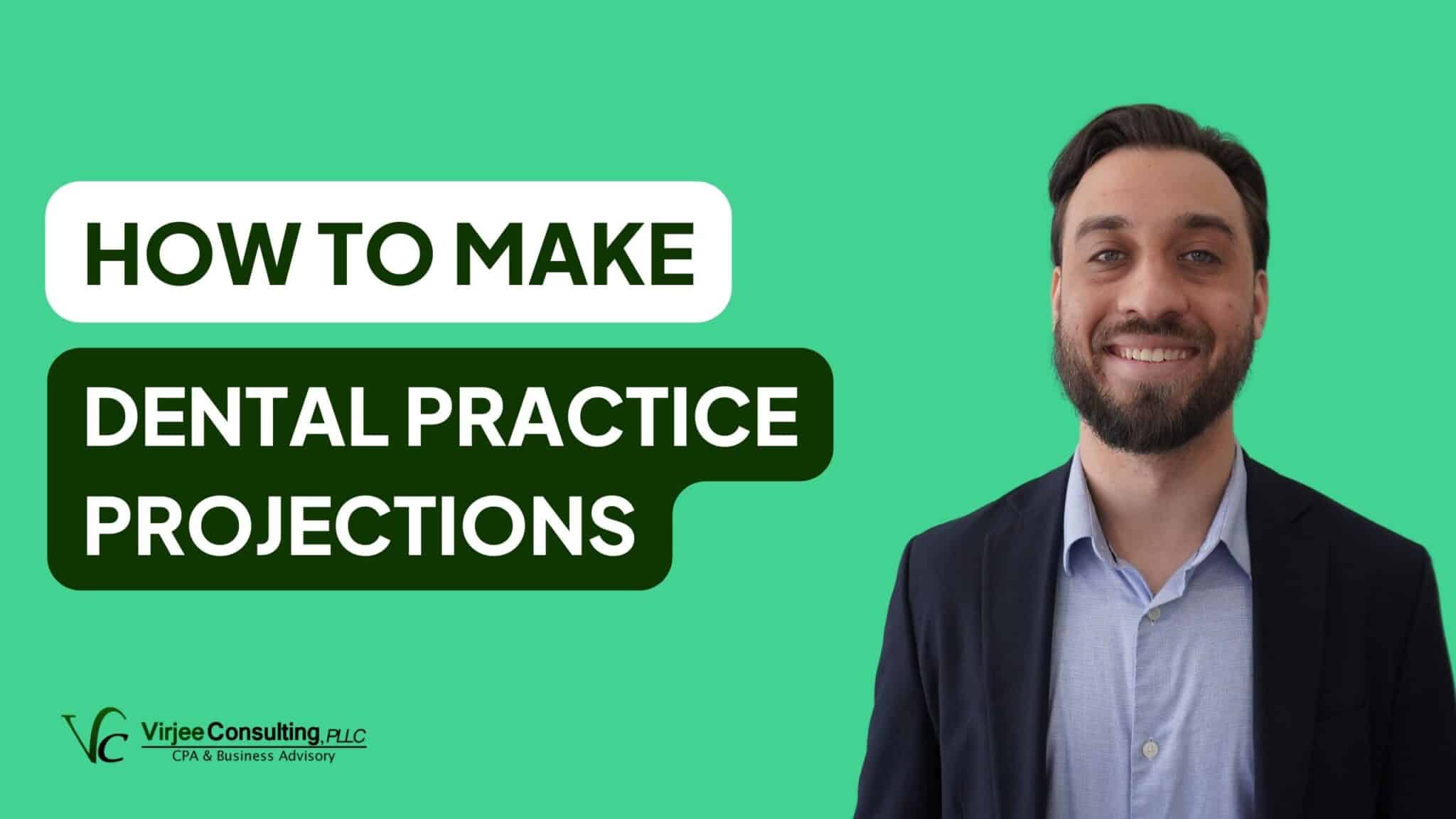At Virjee Consulting, we work with dentists all over the country—owners of single-chair startups, busy multi-location practices, and everything in between.
And there’s one common thread we see among the most successful ones: they plan.
Not just for taxes or staffing or year-end purchases, but for the whole business. They forecast what’s ahead.
I know, I know—“forecasting” sounds like one of those accounting terms that makes your eyes glaze over. But hang with us here, because it’s actually way more approachable than it sounds. You don’t need to be an accountant to create dental practice projections that help you run a smarter, smoother practice.
You just need to know what to look at, how to think about the numbers, and where things might be headed in 2025.
And that’s exactly what this guide is for.
Why Forecasting Matters in 2025
Let’s start with the “why.”
You’ve probably had years where the goal was just to stay on your feet. You juggled patient care, staff issues, supply costs, insurance delays—and somehow kept the lights on.
But in 2025, we’re dealing with a different kind of landscape.
The economy’s still in flux,
inflation has left a mark,
and big decisions – like hiring, expansion, or investing in new technology – feel weightier.
This is why forecasting matters. It gives you a way to map out your financial year before it happens. It doesn’t need to be perfect or even complicated. It just needs to be honest and clear.
When you take the time to think through your revenue streams, expenses, and growth plans, you’ll feel more confident about decisions like bringing on a new associate, upgrading your imaging equipment, or rolling out that marketing campaign you’ve been sitting on.
Instead of guessing, you’re making informed choices—and that makes a big difference.
What Makes Dental Forecasting Different
If you’ve read any generic small business advice about budgeting or planning, you’ve probably noticed it doesn’t really translate well to a dental office.
Your practice isn’t selling sneakers or coffee—it runs on procedure mix, insurance reimbursements, and high fixed costs. That changes the game.
For one, not all dental services behave the same in a shifting economy.
Cleanings and emergency procedures tend to stay stable, while elective services like whitening or veneers might slow down if patients get cautious. If you treat your revenue as one big lump sum, you won’t catch these nuances – and that can lead to over- or under-estimating cash flow.
Then there’s insurance. If insurance makes up a big part of your collections, you already know how tricky it is. Production might be up, but actual collections lag behind thanks to fee schedules, write-offs, and delays. That’s why we always project production and collections separately.
And of course, there’s your overhead. Dental practices have high fixed costs—from staffing to rent to labs to software. That’s not a bad thing, but it means you can’t afford to wing it.
A missed projection or underestimated expense doesn’t just ding your profits—it can derail your whole plan.
The 2025 Reality Check
So, what should you be thinking about as you map out your numbers?
Elective procedures are starting to make a comeback in certain markets—especially in higher-income zip codes—but it’s still a mixed bag.
If cosmetic services are part of your revenue, it’s best to stay conservative in your projections and adjust upward only if you see local demand pick up.
Staffing continues to be a big challenge across the board. We’re seeing hygienists and assistants in high demand, and competitive pay is often the only way to keep your team intact.
If you haven’t adjusted your wage assumptions since last year, it’s time to take a fresh look. Mid-year surprises in payroll are avoidable with a solid forecast.
Financing costs haven’t eased up yet either. While there’s chatter about interest rates dropping later in the year, borrowing is still expensive right now.
If you’re planning to finance equipment or build out your space, assume today’s rates will stick around for a while, and plan accordingly.
How We Build Forecasts With Our Clients (Step by Step)
Whether you’re just opening your doors or you’ve been practicing for 15 years, we walk through the same core steps with every dentist we work with:
1. Start With Real Numbers
The more history you have, the better. If you’ve got 12 to 24 months of data, that’s our starting point.
We typically pull:
- Monthly production broken down by service type
- Collections (total, and by payer when available)
- Staffing and benefits costs
- Lease, software, and other fixed overhead
- Lab fees and variable supply costs
If you don’t have all this, no worries—we can fill in gaps using reliable dental industry benchmarks.
2. Break Revenue Into Buckets
We don’t lump your income into one big number. Instead, we break it out by procedure to see where your money’s really coming from:
| Service | Average Fee | Monthly Patient Volume | Monthly Revenue |
| Cleanings | $120 | 180 | $21,600 |
| Fillings | $200 | 100 | $20,000 |
| Whitening | $350 | 25 | $8,750 |
This gives us the flexibility to model changes. For example, what happens if whitening slows down by 30%? Or if a recall push brings in more preventative visits? You’ll be able to see the ripple effects.
3. Model Three Versions of the Future
We never stop at just one version of the forecast.
Instead, we model three:
- Base case: What you expect to happen this year
- Optimistic case: If things go better than planned—higher demand, better staffing, cosmetic bounce-back
- Conservative case: If cosmetic services slow, no-shows rise, or reimbursements change
This gives you a clearer picture and a plan—no matter what direction the year takes.
4. Adjust for Seasonality
Every practice has patterns. Maybe you’re slammed in December when patients use up insurance, or things slow down every July when families go on vacation.
We look at your historical data and adjust your monthly projections accordingly. A flat “divide by 12” approach won’t cut it.
5. Add in Planned Changes
Forecasts aren’t just about where you’ve been—they’re about where you’re going.
If you’re:
- Hiring an associate
- Launching a marketing campaign
- Investing in a CBCT or other big-ticket item
We factor all of that in. Not just the costs, but the timing and the expected return. That way, your forecast reflects reality – not just hope.
The KPIs That Keep Your Forecast on Track
Once the forecast is in place, we don’t just set it and forget it. We meet with clients throughout the year to track a handful of KPIs—key performance indicators—that tell us whether things are moving in the right direction.
We always keep an eye on production per provider. That number tells us how efficiently the team is working and where to dig deeper if something seems off.
We compare production to collections to make sure receivables aren’t slipping through the cracks.
Staffing costs get tracked as a percentage of revenue, so we know if we’re staying lean or drifting into bloated territory.
We also track your overhead ratio and your average revenue per patient, which helps us spot pricing or efficiency issues.
And we always look at case acceptance rates – because it doesn’t matter how many treatment plans you present if patients aren’t saying yes.
These aren’t just abstract numbers. They tell the story of how your practice is running—and whether your forecast needs a tune-up along the way.
Ready to Build Your Forecast With Confidence?
If you’re tired of guessing – or if you’ve outgrown the “back-of-the-napkin” approach – it might be time to bring in some help.
Here at Virjee Consulting, we will walk you through your 2025 forecast step by step, using real numbers and industry insight.
No guesswork.
No spreadsheet headaches.
Just a clear plan that reflects your practice, your goals, and your suburb’s unique economic reality.
Book your first introductory call with us and let’s build something better together.
Simply use the calendar below to get started.
Until next time.

